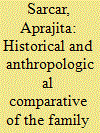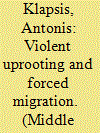| Srl | Item |
| 1 |
ID:
177693


|
|
|
|
|
| Summary/Abstract |
This study aims to document the age structure and mortality by age in the Ottoman city of Bursa that served as a politically and commercially significant urban center over centuries. It uses a set of hitherto unexamined Ottoman population registers kept in 1839 and updated until 1842 that provide detailed self-reported data on all male inhabitants regardless of age, including deaths, births, and migration. The study tests the quality of age and mortality data in conjunction with the Coale and Demeny regional model life tables and compares the results to historical demographic studies conducted for European regions. The results point to a demographic structure marked by high birth and death rates and prove promising for extending back the study of Ottoman demographic transition and establishing historical comparison points with the global experience.
|
|
|
|
|
|
|
|
|
|
|
|
|
|
|
|
| 2 |
ID:
141718


|
|
|
|
|
| Summary/Abstract |
The article tracks the evolution of the family planning programmes in India and China and the conceptual linkages between the two. This comparison, in turn, serves as an entry point for studying the following:
The role that the family plays in becoming the site of governance and deploying state-led capitalism in the two countries.
The assumptions behind the development trajectories in both countries.
What are the ways in which the policies amplified patrilineal hierarchies within families to produce the disturbing outcome of the missing girl child—this even as the family planning policies became constrained as they were acting within a cultural milieu of patriarchy.
The article uses studies and commentaries across disciplines, such as, historical demography and anthropology to situate its arguments. The conclusion it attempts to put forth is that the small family norm was operationalised in various differing ways in both states, and yet the commonalities that arose were the following:
The declining sex ratio in both states as an immediate repercussion of the enforcement of the small family norm.
The structuring of the health services around the family planning operations.
The small family norm becoming an end in itself, as a mode of reaching a level of development akin to the West, and as an ethic for modernising nations.
|
|
|
|
|
|
|
|
|
|
|
|
|
|
|
|
| 3 |
ID:
131461


|
|
|
|
|
| Publication |
2014.
|
| Summary/Abstract |
This article systematically examines the historical demography of Greek refugees from Asia Minor, Pontus and Eastern Thrace from the beginning of the 1910s until the aftermath of the signing of the Convention of Lausanne and even later until 1928 when the first general census after the Asia Minor Disaster of 1922 took place in Greece. In this context, the article focuses firstly on a comparative examination of the available sources concerning the number of Greeks living in Asia Minor, Pontus and Eastern Thrace before the outbreak of the First World War, and secondly on the number of refugees pouring into Greece before and after the Asia Minor Disaster of 1922. It is argued that the Greeks of Asia Minor and Pontus suffered numerous losses because of the persecution by the Turkish authorities and because of their violent uprooting from their homelands. On the other hand, it is argued that the Greek population of Eastern Thrace was in general much less affected by the Turkish atrocities despite the fact that even this population was obliged to seek refuge in Greece after 1922.
|
|
|
|
|
|
|
|
|
|
|
|
|
|
|
|